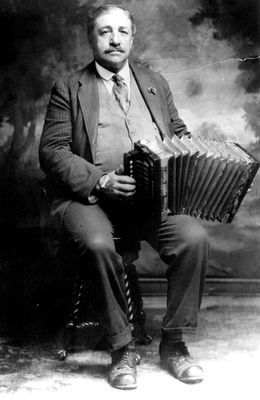Annotation:Rags (The): Difference between revisions
No edit summary |
No edit summary |
||
| (13 intermediate revisions by 3 users not shown) | |||
| Line 1: | Line 1: | ||
---------- | |||
---- | {{TuneAnnotation | ||
|f_tune_annotation_title= https://tunearch.org/wiki/Annotation:Rags_(The) > | |||
'''RAGS, THE''' (Les Guenilles). AKA | |f_annotation=[[File:montmarquette.jpg|260px|thumb|right|Alfred Montmarquette]]'''RAGS, THE''' (Les Guenilles). AKA – "[[Guenille (La)]]," "[[Guénille (La)]]," "[[Reel de la guénille]]." French-Canadian, Reel and Air. D Major. Standard tuning (fiddle). AABBCCCC (Phillips): AA'BB'CC' (Reiner & Anick). A common French-Canadian reel, according to David Green in the liner notes to “Louis Beaudoin” (Philo Records, 1973). The title refers to a piece of cloth, not 'ragtime' rhythm. The tune was popularized through the performances of accordion player [[wikipedia:Alfred Montmarquette]] (1871–1944) and singer Mary Travers (La Bolduc), who set words to it. It was also recorded by fiddlers [[wikipedia:Joseph_Allard_(fiddle)]] and Isidore Soucy [https://www.thecanadianencyclopedia.ca/en/article/isidore-soucy-emc] and by numerous accordion players. Paul Fackler points out that Leo Beaudoin played a 3-part version of the tune, with a third part that is not included in Montparquette's or Soucy's version. | ||
|f_source_for_notated_version=Dennis Mathieu via Louis Beaudoin (1921–1980, Burlington, Vt.) [Reiner & Anick]; Ken Kosek [Phillips]; Leo Beaudoin ['''Sing Out''']. | |||
|f_printed_sources=Olivier Demers ('''1000 airs du Québec et de l’Amérique francophone'''), 2020; p. 107. | |||
Hart & Sandall ('''Dance ce soir!'''), 2001; No. 14, p. 47. | |||
Phillips ('''Traditional American Fiddle Tunes, vol. 1'''), 1994; p. 194. | |||
'' | Reiner & Anick ('''Old-Time Fiddling Across America'''), 1989; p. 64. | ||
'''Sing Out''', vol. 52, No. 3, Autumn 2008; p. 71). | |||
|f_recorded_sources=Bluebird B-4887 (78 RPM), Joseph Allard (1936). | |||
Folkways Records RBF 111, Alfred Montmarquette – "Masters of French-Canadian Music, Vol. 2" (1980). | |||
Grooveless Records, Arm & Hammer String Band – "Stay on the Farm" (1978). | |||
'' | Philo 2000, "Louis Beaudoin" (1973. Learned in Burlington, Vt., from Dennis Mathieu). | ||
Calvin Volroth – "Tunes From My Past." | |||
Philo Records, Louis Beaudoin" (1973). | |||
RCA Victor CGPS-215, Isidore Soucy – "La veillée chez Isidore" (1968). | |||
SOCAN MPCD 2039, La Bottine Souriante – "En spectacle" (1996). | |||
Starr Records 15491 (78 RPM), Alfred Montmarquette (1928). | |||
Victor 263593 (78 RPM), Tezraf Latour {1888–1932, accordion} (1929). | |||
|f_see_also_listing=Hear Fernando Soucy's 1972 recording on youtube.com [https://www.youtube.com/watch?v=JICDfnDr_rg]<br> | |||
Hear Fernando Soucy's 1972 recording on youtube.com [https://www.youtube.com/watch?v=JICDfnDr_rg]<br> | Hear Alfred Montmarquette's recording on youtube.com [https://www.youtube.com/watch?v=xMDCRwAwbjs] [https://www.youtube.com/watch?v=nhGga34a_fs] and at the Virtual Gramophone [http://www.collectionscanada.gc.ca/obj/m2/f7/15912.mp3]<br> | ||
Hear Tezraf Latour's 1936 recording at the Virtual Gramophone [http://www.collectionscanada.gc.ca/obj/m2/f7/12664.mp3]<br> | |||
<br> | }} | ||
<br> | ------------- | ||
---- | |||
Latest revision as of 04:14, 15 May 2023
X:1 T:Guenilles, Les T:Rags, The M:C| L:1/8 R:Reel N:M. Beaudoin played each part three times. D:Philo Records - "Louis Beaudoin" (1973) D:https://www.youtube.com/watch?v=HRhhNNiblxs Z:Andrew Kuntz K:D Acdd fdfd|cdef gfgB|Aceg fdfd|efec d2d2| Acdd fdfd|cdef gfg2|Aceg fdfd|1,2egec d2d2:|3egec d3|| |:a|a2ag fdfd|Acde gefg|abag fdfd|egec d3:| |:f|gage fgfg/f/|edcB Acef|gage f2 fg/f/|egec d3:|


